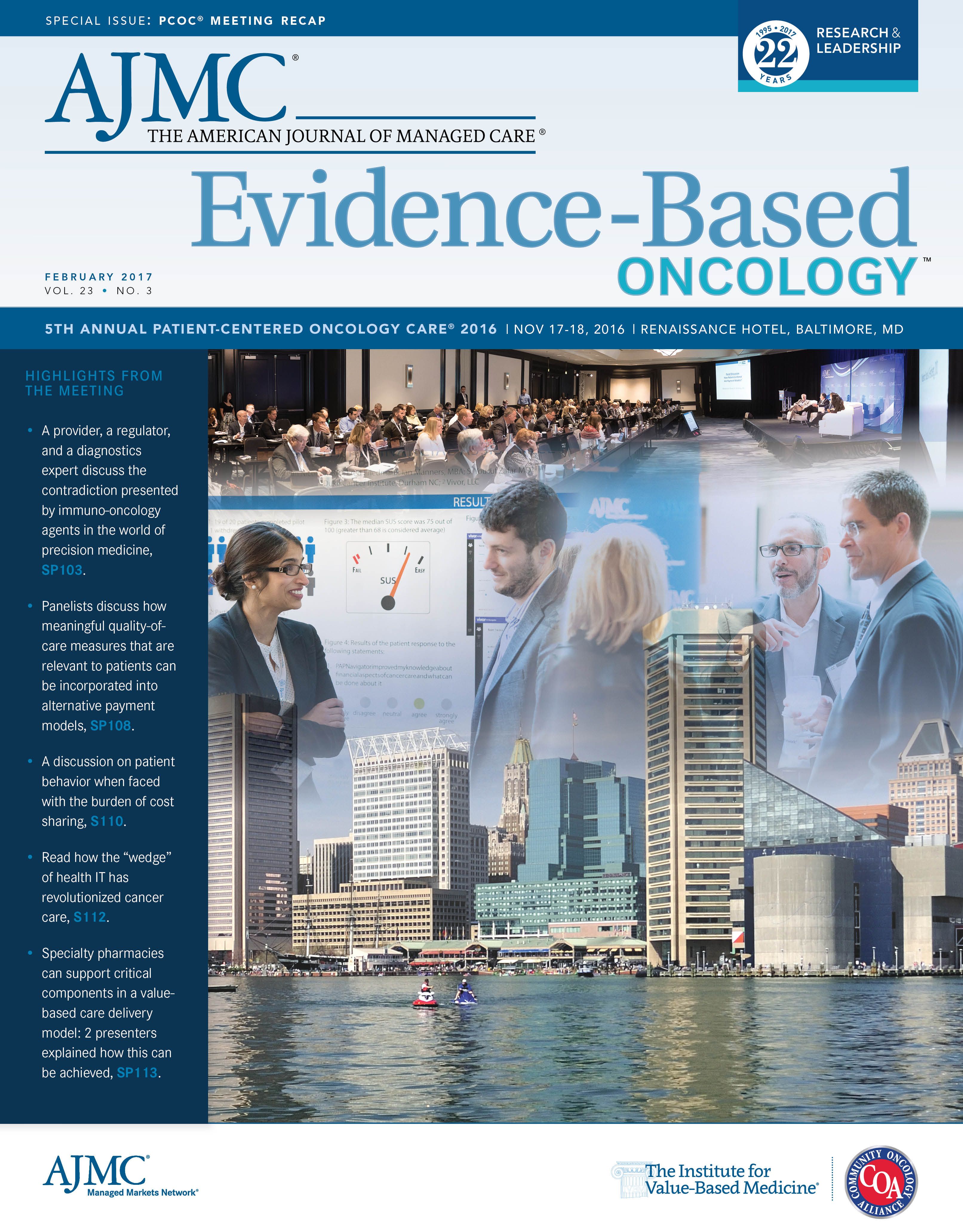- Center on Health Equity & Access
- Clinical
- Health Care Cost
- Health Care Delivery
- Insurance
- Policy
- Technology
- Value-Based Care
Integrating Patient-Centered Outcomes in APMs
As payment models shift to emphasize patient experience and quality of care, a panel discussion at the 5th annual Patient-Centered Oncology Care® meeting debated whether these efforts had meaningfully improved outcomes for patients.
HEALTH PLANS ARE INCREASINGLY CREATING
contracts with providers that tie the quality of care to payment decisions, a trend that has already made its mark in oncology with bundled and episodic payments. While most find it difficult to move away from process measures, clinics are transitioning toward more meaningful quality-of-care measures. But do these measures really improve patient care?
At the 5th annual Patient-Centered Oncology Care® meeting in Baltimore, which was held on November 17-18, 2016, moderator Bruce Feinberg, DO, was joined by Bhuvana Sagar, MD, national medical director, Cigna Healthcare; Ted Okon, MBA, executive director, Community Oncology Alliance; and Stuart Goldberg, MD, chief medical officer, Cancer Outcomes Tracking and Analysis (COTA), John Theurer Cancer Center, for the panel discussion, “How Patient-Centered Are Payment Models?”
Feinberg asked the panel, “How patient-centered is medicine today?” Goldberg explained that everyone defines value as the ratio of outcomes to cost, the most important part of which is defining the outcomes that are important. “At COTA, we track all the outcomes and costs. But what we can argue is, ‘What does the patient see as value… survival or quality?’” Goldberg thinks that the field has so far been unsuccessful in adequately defining patient-centered outcomes.
Referencing Cigna’s value-based models, Sagar pointed out that the patient constitutes the core of their medical home model, adding, “But we want to ensure that the provider is capable of delivering the required care.” Sagar iterated that information sharing, shared decision making, early palliation, and addressing emotional and physical symptoms are some of the tenets of their patient-centered medical home model. “We also offer case managers to help providers and patients navigate the care journey.”
She echoed Goldberg’s thoughts, saying that the focus should be patient outcomes, not just process measures. “We need to navigate patients through other aspects of their care, such as financial processes. However, we are currently a little stuck in our journey toward value-based care.”
Okon told the audience that at the recent Community Oncology Alliance (COA) Payer Summit,1 “We had a lot of focus on the [Oncology Care Model (OCM)]. We are big proponents of the OCM, but part of the problem is that anyone involved in the OCM model knows it is process-centric.”
Speaking to the exhaustive reporting requirements of the various new alternative payment models, Goldberg said that the time that a care provider has to spend in documenting data is increasing. “At our community centers, we are constantly moving patients around our network…but it’s tough. It’s hard to measure quality metrics and outcomes when you are in the blind with the kind of patients you are treating.”
Okon said that he believes it’s time for care providers and payers to move on to the next iteration of the OCM. He believes that CMS’ Innovation Center, which developed the OCM, needs to change its focus. “They should ask the provider, ‘Where are you going with your treatment…curative, palliative, or recurrence?’ COA is in conversation with CMS about OCM 2.0—to move away from processes and make it really patient-centered.”
Coming from a health plan, Sagar believes in giving this transition some more time. “Value-based care is a step in the right direction…there will be a lot of learning and implementing for both payers and providers.” She believes, however, that although better survival is the outcome that care providers and payers want for their patient, “We also want to improve their care journey.”
This was the idea rooted in COA’s Oncology Medical Home (OMH),2 Okon told the audience. “When we initiated OMH 5 years back, Dr Bruce Gould spearheaded the project,” he said. Gould connected with other providers, payers, and patients, and developed patient focus groups to collect information on what patients’ value most and what they expect from their cancer care. “Turned out, all 3 groups were interested in outcomes. Then it diverged a little bit, but their interests were similar,” Okon said.
“Our focus is to ensure that patients have all the information they need, they get evidence-based guidelines, and they have access to their doctor,” Sagar said. She added that patients being treated for cancer are a difficult population to manage, primarily because of the complexity of the disease at hand. “So, we look at centers of excellence and other options. We want to make sure they are getting their treatment. We just want to identify the ideal place to receive care while managing costs…and keeping those costs down.”
REFERENCES
On their end, providers are working to identify the sources of variance, so they can try to limit them while preventing waste within the system. “The OCM model, for us, is the first step toward the value model,” Goldberg told the audience. “There’s a lot of waste or lower-value care being delivered, plus variability in care delivered within the same center. We are trying to identify this variance.”
- COA Payer Exchange Summit 2016. The American Journal of Managed Care® website. http://www.ajmc.com/conferences/coa-payer-exchange-summit-2016. Published October 25-26, 2016. Accessed November 23, 2016.
- Oncology Medical Home website. http://www.medicalhomeoncology.org/. Accessed November 23, 2016.

Trends in Hospital Pricing for Vulnerable Emergency Department Users, 2021-2023
December 4th 2025Self-pay emergency department prices rose significantly from 2021 to 2023, especially at for-profit and system-affiliated hospitals, highlighting growing affordability challenges for uninsured and underinsured patients.
Read More
Blister Packs May Help Solve Medication Adherence Challenges and Lower Health Care Costs
June 10th 2025Julia Lucaci, PharmD, MS, of Becton, Dickinson and Company, discusses the benefits of blister packaging for chronic medications, advocating for payer incentives to boost medication adherence and improve health outcomes.
Listen

